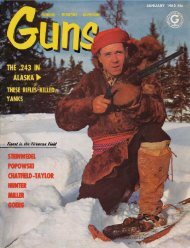GUNS Magazine January 1960 - Jeffersonian
GUNS Magazine January 1960 - Jeffersonian
GUNS Magazine January 1960 - Jeffersonian
Create successful ePaper yourself
Turn your PDF publications into a flip-book with our unique Google optimized e-Paper software.
owse was abundant. The area was difficult to reach, so<br />
both deer and timber were left to their own resources<br />
without outside intervention.<br />
Between 1918 and 1924, the deer herds grew from an<br />
estimated 20,000 head to over 100,000. However, experts<br />
estimated the food supply was capable of supporting only<br />
about 32,000 deer.<br />
More than three times the natural number of deer fed<br />
on the tender browse, so it was soon eaten out. Thousands<br />
of deer starved and thousands of young trees were stripped<br />
of their life-giving foliage. Arguments raged-should the<br />
surplus deer be harvested? Several highly qualified observers<br />
believe the Kaibab deer population hit bottom with<br />
less than 5,000 surviving.<br />
Nature maintains a balance between wildlife and its food<br />
supply-the forest. When deer populations outgrow the<br />
food supply, as they did on the Kaibab range, starvation<br />
drasticany cuts the numbers. If they didn't die, too many<br />
deer stripping young trees of edible bark could kill the<br />
forest itself.<br />
A 1948 survey in Wisconsin determined that the overabundant<br />
deer population there was destroying young trees<br />
at a rate one hundred times that season's loss by forest<br />
fires. So the deer population is reduced by Nature to preserve<br />
the forest. This is one of the fundamental concepts of<br />
conservation.<br />
While the primary purpose of a Tree Farm is to grow<br />
timber as a crop for use in the manufacture of more than<br />
5,000 items Americans use every day, the n1Y.ltiple use of<br />
these timber holdings benefits both sportsman and forester.<br />
Planned harvests of the surplus big game helps to maintain<br />
Nature's balance and prevent useless wildlife waste by<br />
starvation. Keeping this balance helps, too, in giving the<br />
forest an opportunity to rejuvenate itself and replace the<br />
trees harvested for their wood. Studies have shown that<br />
harvesting the surplus deer eases the eruption and collapse<br />
pattern demonstrated by the Kaibab deer, and it saves the<br />
forest from the rampage of hungry mouths seeking out the<br />
young and tender shoots of new forest growth.<br />
Conservationists know that a healthy deer herd can more<br />
than double its size in just one season-so planned harvesting<br />
is vital. And planned harvesting, of its "twin crops," is<br />
vital to the Tree Farm concept.<br />
The Tree Farm Program, though still in its infancy, is a<br />
nationwide movement begun by the wood-using industries.<br />
Its purpose is to bring many smaller forest properties under<br />
good timberland management. Most of the larger holdings<br />
are accredited Tree Farms and thousands of the smaller<br />
ones are enrolling in this tree-growing movement.<br />
The interest which started this project is, naturally, a<br />
business one-to assure a high level of production, yet<br />
guarantee a future wood supply. To become a Tree Farm<br />
in this National system, a forest property must be privately<br />
owned, tax-paying and dedicated to growing repeated crops<br />
of timber. It must be managed in accordance with good<br />
forest management practices including protection against<br />
fire, insects, disease and destructive grazing. The accredited<br />
tree farmer must necessarily give consideration to other inherent<br />
values of the woods as watershed protection, wildlife<br />
and recreation areas. Increased wood production is foremost,<br />
but wildlife production is also increased by good forest<br />
management. Information on the Tree Farm System is<br />
available from American Forest Products Industries, 1816 N<br />
Street N.W., Washington 6, D.C. (Continued on page 52)<br />
Pete Mondino of III. gun club calls ducks<br />
at Drumstra tree farm. Club members help<br />
reduce fire hazard. Above, Weyerheuser timberman<br />
marks a company cabin for hunters' use.<br />
26 <strong>GUNS</strong> JANUARY <strong>1960</strong>

















